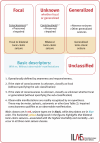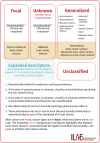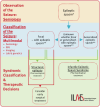B.J. serves as associate editor of the journal Neurology. She has received research support from NIH, CDC, and Neuropace. D.C. has received educational grants from UCB, Astra Zeneca, and Desitin and is a member of the advisory board of Astra Zeneca and UCB. D.C. is a chair of the Education and Training Committee and of the Guidelines Committee of the European Pediatric Neurology Society. D.C. has no conflicts of interest related to this article. E.T. has received personal honoraria for lectures and educational activities from EVER Pharma, Marinus, Arvelle, Angelini, Alexion, Argenx, Medtronic, Biocodex, Bial‐Portela & Ca, NewBridge, GL Pharma, GlaxoSmithKline, Boehringer Ingelheim, LivaNova, Eisai, Epilog, UCB, Biogen, Sanofi, Jazz Pharmaceuticals, and Actavis; his institution has received research grants from Biogen, UCB Pharma, Eisai, Red Bull, Merck, Bayer, the European Union, FWF Osterreichischer Fond zur Wissenschaftsforderung Bundesministerium für Wissenschaft und Forschung, and Jubiläumsfond der Österreichischen Nationalbank. E.W. serves as a data and safety monitoring board member for Neurocrine, Acadia, GRIN Therapeutics, and Encoded. F.C. has received speaker honoraria or consultancy fees from UCB Pharma, Eurofarma, Libbs, Torrent, Adium, Abbott, Prati Donaduzzi, Takeda, and Biocodex. He has also received institutional grants from the Sao Paulo Research Foundation and Conselho Nacional de Desenvolvimento Científico e Tecnológico. He is the editor‐in‐chief of Epilepsia. J.F. receives salary support from the Epilepsy Foundation and from the Epilepsy Study Consortium for consulting work and/or attending scientific advisory boards for Acadia Pharmaceuticals, Acuta Capital Partners, Agrithera, Alterity Therapeutics Limited, Angelini Pharma, Autifony Therapeutics Limited, Axonis Therapeutics, Baergic Bio, Beacon Biosignals, Biogen, Biohaven Pharmaceuticals, Bloom Science, Bright Minds Biosciences, Camp4 Therapeutics Corporation, Cerebral Therapeutics, Cerecin, Cerevel, Cognizance Biomarkers, Cowen and Company, Crossject, Eisai, Encoded Therapeutics, Engrail, Epalex, Epitel, Equilibre BioPharmaceuticals, Genentech, GRIN Therapeutics, IQVIA RDS, iQure Pharma, Janssen Pharmaceutica, Jazz Pharmaceuticals, Korro Bio, Leal Therapeutics, Lipocine, LivaNova, Longboard Pharmaceuticals, Marinus, Modulight.bio, Neumirna Therapeutics, Neurocrine, Neuronetics, NeuroPace, NeuroPro Therapeutics, Neuroventis, Ono Pharmaceutical Co., Otsuka Pharmaceutical Development, Ovid Therapeutics, Paladin Labs, Praxis, PureTech, Rapport Therapeutics, Receptor Holdings, Sage Therapeutics, SK Life Sciences, Stoke, Supernus, Takeda, Third Rock Ventures, UCB, Ventus Therapeutics, Vida Ventures Management, and Xenon. J.F. has also received research support from the Epilepsy Study Consortium (funded by Eisai and UCB), Epilepsy Study Consortium/Epilepsy Foundation (funded by UCB), GW/FACES/One8Foundation, and NINDS. She is on the editorial board of Lancet Neurology and Neurology Today. She is chief medical/innovation officer for the Epilepsy Foundation. She is the president and on the board of directors for the Epilepsy Study Consortium. She has received travel/meal reimbursement related to research, advisory meetings, or presentation of results at scientific meetings from the Epilepsy Study Consortium, the Epilepsy Foundation, Angelini Pharma, Biohaven Pharmaceuticals, Cerebral Therapeutics, Cowen and Company, Longboard, Neurelis, Neurocrine, NeuroPace, Praxis, Rapport, SK Life Science, Stoke, Takeda, and Xenon. J.H.C. has acted as an investigator for studies with GW Pharma/Jazz Pharmaceuticals, Zogenix/UCB, Vitaflo, Stoke Therapeutics, Ultragenyx, and Marinius. She has been a speaker and on advisory boards for Jazz Pharmaceuticals, UCB, Biocodex, and Nutricia; all remuneration has been paid to her department. She holds an endowed chair at UCL Great Ormond Street Institute of Child Health; she holds grants from National Institute of Health Research (NIHR), EPSRC, GOSH Charity, LifeARC, and the NIHR Biomedical Research Centre at Great Ormond Street Hospital. She is president of the ILAE 2021–2025. J.W. is on the national (South African) advisory board for Novartis and Sanofi and is an associate editor of Epilepsia (honorarium for work covered). M.S. served as editor‐in‐chief of Epilepsia. He has received compensation for speaking in continuing medical education (CME) programs from Medscape. He has consulted for Medtronic, Neurelis, and Johnson & Johnson. He has received research support from Medtronic, SK Life Science, Takeda, Xenon, Cerevel, UCB Pharma, Janssen, Equilibre, Epiwatch, Byteflies, and Biohaven. He has received royalties from Oxford University Press and Cambridge University Press. N.S. has served on scientific advisory boards for GW Pharma, BioMarin, Arvelle, Marinus, and Takeda; has received speaker honoraria from Eisai, BioMarin, LivaNova, and Sanofi; and has served as an investigator for Zogenix, Marinus, BioMarin, UCB, and Roche. He has been supported by #NEXTGENERATIONEU and funded by the Ministry of University and Research, National Recovery and Resilience Plan, project MNESYS (PE0000006): A Multiscale Integrated Approach to the Study of the Nervous System in Health and Disease (DN. 1553 11.10.2022). He has also been supported by the Italian Ministry of Health with Current Research Funds. S.A. is deputy editor for Epilepsia; has served as a consultant or received honoraria for lectures from Angelini Pharma, Biocodex, Eisai, Encoded, Jazz Pharmaceutics, GRIN Therapeutics, Neuraxpharm, Nutricia, Orion, Proveca, Stoke, Takeda, UCB Pharma, and Xenon; and has been an investigator for clinical trials for Eisai, Marinus, UCB Pharma, Proveca, and Takeda. S.B. serves as editor‐in‐chief of Epileptic Disorders. He has received compensation for speaking in CME programs from Lundbeck, Eisai, UCB and GSK. He has received research support from Independent Research Fund Denmark, Innovation Fund Denmark, European Union: Eurostars Program/EUREKA, European Union: Horizon Europe Framework Program, and Danish Agency for Higher Education and Science: International Network Program. S.W. has received educational grants on behalf of his institution from UCB Pharma, Jazz Pharmaceuticals, and Paladin Labs and has served on the advisory board of Paladin Labs. The remaining authors report no conflicts of interest directly related to this paper. We confirm that we have read the Journal's position on issues involved in ethical publication and affirm that this report is consistent with those guidelines.




